Brand Identity 101: How to Create a Unique Brand(+ FREE Worksheet!)
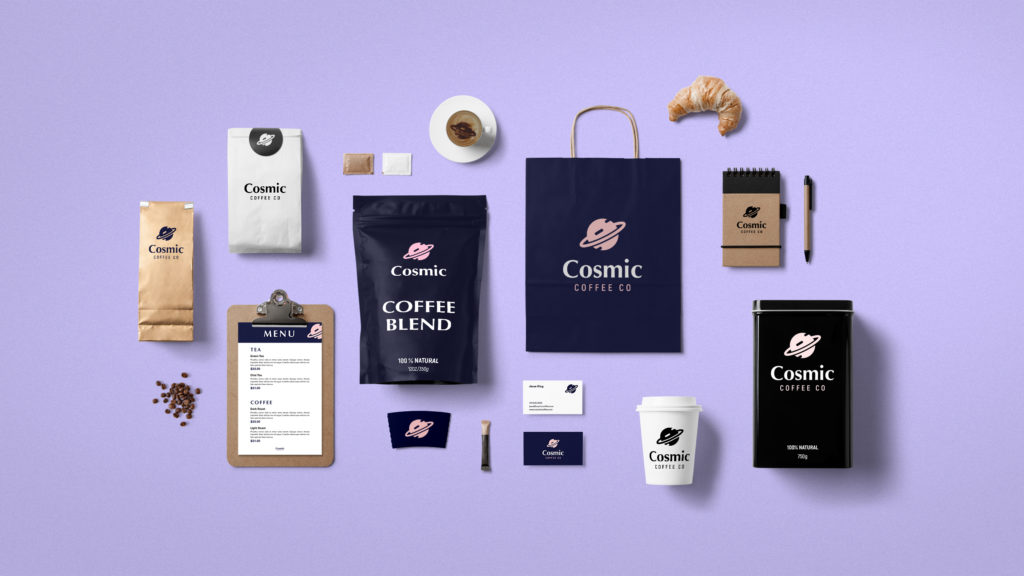
Starting a business is both exciting and daunting. But what about creating an entire brand identity? Branding tells the world who you are, what you’re about, and what people can expect from interacting with your business. It’s a big deal!
The good news is, that creating a brand identity is fun and easy. You get to turn your business into an entity that will live in the minds of your customers for time to come. A Brand identity will help you gain customer loyalty and referrals, build trust, and increase the perceived value and price of your product or service.
We know building a strong brand identity with no design experience seems intimidating, but this guide and worksheet will cover the tools and knowledge you need to build a memorable brand identity you’ll love.
We’ll cover:
Ready? Let’s hop to it!
What is a brand identity?
A brand identity is the physical and digital result of branding. It is the collection of brand elements that a company creates to portray the right image of itself to its target audience. These elements comprise the visual branding your audience can see and recognize as yours.

What is a brand?: A brand is a business concept that helps people identify a product, person, or business. It’s the overall perception of your business. Since perceptions only live in the mind, a brand only truly exists in customers’ minds.
What is branding?: To build a brand, you’ll need to practice the art of branding. Branding is the actions you take to create a distinctive, memorable brand. It’s the (hard) work you put into developing your desired image.
Brand assets are the elements that make up your visual brand identity. These are the unique identifying pieces that distinguish your brand from others. Having brand assets gives you a competitive edge by encouraging customer recognition.

Your brand assets are automatically associated with your brand in the minds of consumers, which helps build brand loyalty. Here are some examples of brand assets:
- Brand name
- Logo
- Tagline/slogan
- Typography
- Color palette
- Mascot
- Jingles
What are brand guidelines?: Brand guidelines (also called a style guide) are a set of rules about how to represent your brand across channels and assets. They include color and typography usage rules, logo use cases, imagery examples, and more.
Why a strong brand identity is important
Here are a few reasons why branding and brand identity are so important:
- Branding builds customer loyalty and referrals. People choose and recommend companies they like and are familiar with.
- Branding helps you stand out from the competition. Stand out from competitors with a strong brand and live up to what it promises.
- Branding builds recognition. A consistent brand helps customers know what quality to expect every time they interact with your business.
- Branding helps you create clarity and stay focused. A clear brand strategy and purpose help you stay focused on your mission and make better decisions.
- Branding helps you connect with your customers emotionally. A good brand makes people feel good when they buy your products or services. Tell a story or stand up for something!
- Branding helps you stay consistent. Brand guidelines save you time and keep you visually consistent.
Learn more about branding trends here!
Successful brand identity examples
Let’s look at some global brand identity examples as proof of what a strong brand identity design can do.
1. Patagonia

Patagonia uses a striking wordmark logo with a mountain range at dusk as a backdrop. Unlike the simple sans serif fonts of its competitors, it uses a lowercase, thick, rounded serif font to differentiate itself. But, what truly makes Patagonia’s successful brand image is its brand personality and brand marketing.

They have a sincere brand personality and wholesome, honest, and down-to-earth brand values. Patagonia is centered around high-quality products that are sustainable and adventure-proof. These values are all closely stitched into its brand voice, messaging, and marketing assets.
2. Starbucks

Starbucks’s logo, the siren, has undergone several redesigns over the years but continues to symbolize the company’s rich and adventurous spirit. The logo features a stylized, two-tailed siren. The current logo focuses on the siren’s face, and the negative space around her creates a sleek and modern look that appeals to coffee lovers worldwide.
The brand’s signature green brand color (hex #296044) suggests stability and endurance, qualities that Starbucks aspired to as it expanded its reach globally.
2. Mailchimp

Mailchimp boldly ripped itself away from the professional and “boring” appearance of most email marketing platforms and created a memorable brand that’s refreshing, fun, and friendly. Although most people don’t associate these traits with email marketing, Mailchimp does.
Its mascot logo, Freddie the winking monkey, is memorable, light-hearted, and the face of Mailchimp. The brand uses yellow to associate emotions of laughter and sunshine, along with bubbly pink and blue as accents. The quirky sans serif logo font is paired with a bubbly serif header text that’s unique and legible. There’s no mistaking Mailchimp for another!
3. Warby Parker

Warby Parker’s brand identity is simple and approachable. Much like its products and services! It disrupted the expensive eyeglass industry with its affordable, high-quality glasses and no-nonsense pricing. They use blue to instill trust and professionalism into the brand and a simple, spaced-out minimalist font for clear communication.
These brand identity examples are powerful, with their messaging and brand voice all aligned to their values and customers.
4. Gucci

The iconic Gucci logo is a symbol of luxury, sophistication, and style in the world of fashion. The monogram logo features interlocking Gs, showcasing two overlapping Gs in an alternating style.
The Granjon Roman font, used for both the interlocking Gs and the company’s wordmark, infuses the overall design with a refined and classic touch. This font choice helps convey the brand’s high-end and esteemed image, ensuring that the logo remains a timeless and classic representation of Gucci’s values
How to create a brand identity in 5 steps
Knowing the difference between brands, branding, and brand identities, how can you apply this knowledge to your business and brand strategy?
Here’s how to do it in five simple steps, record your research and notes on our follow-along brand identity worksheet!
1. Find your niche and study competitors
A major part of creating a strong brand identity is figuring out where your place is in the market, and knowing if there’s a demand for what you offer. Once you have an idea of this, take a look at your competitors and figure out what they’re doing, and how you can do it better.
- What is their messaging like?
- Which brand colors do they use?
- What is their typography?
- What are their shapes and imagery?
Take the sum of all the marketing touchpoints and business initiatives of your competitors and define how you can do better while staying true to who you are.
2. Define your target audience

Source: Creative Market
It’s not possible to satisfy everyone. So tailor your mission and messaging to your target audience by answering the following:
- What are their demographics?
- How do they get their information?
- What are their hobbies?
- Do they face any challenges?
- What is important to them?
Create a few marketing personas that are hypothetical hybrids of your ideal customer. We’ve set up a chart for you to add your research to in our brand identity worksheet.
Having a visual of who your ideal customers are will give you clarity as you carry on with the next steps of your brand identity.
3. Define your purpose and why
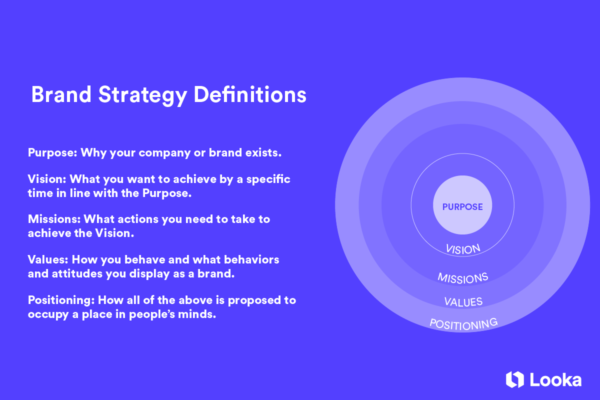
What is your company most passionate about? What’s your reason for existing? Do you stand for a cause?
Your purpose is the driving force behind any and all things that you do. Every single aspect of your branding needs to reflect this to ensure a strong brand identity. Defining the following will give you more direction:
- Vision – the what. This is the sole reason for your brand’s existence
- Mission – the how. The action that your brand is taking to bring your vision to life
- Brand values – the why. The driving force behind your vision and mission
Feeling overwhelmed? Here’s an example:
Let’s take a look at Slack, an online communication platform for businesses. Their vision is to “make work-life simpler, more pleasant, and more productive.”

Their mission — how they’re doing this — is by working with global partners and developers to “Build apps and integrations that streamline work, automate mundane tasks and bring context into conversations.” By reading their vision, you understand the platform’s simplicity and productiveness in a pleasant workplace.
4. Choose a business name
What catchy and creative business name will best describe who you are and what you do? As your main identifier, it’s critical to find a name that personifies your brand.
How do you come up with this key element? Here are a few ideas to get the wheels turning:
- Address the business’ purpose – Example: DoorDash
- Make up a word – Example Häagen-Daz
- Alter an existing word by adding or removing letters – Example: Flickr
- Look to Latin – Example: Volvo (Latin for “I roll”)
- Make a portmanteau – Example: Facebook (a combination of two words, Face + Book)
- Use an acronym – Example: BMW (Bayerische Motoren Werke)
- Use real people’s names – Example: Clif Bar
- Choose a place – Example: Amazon (the largest river in the world
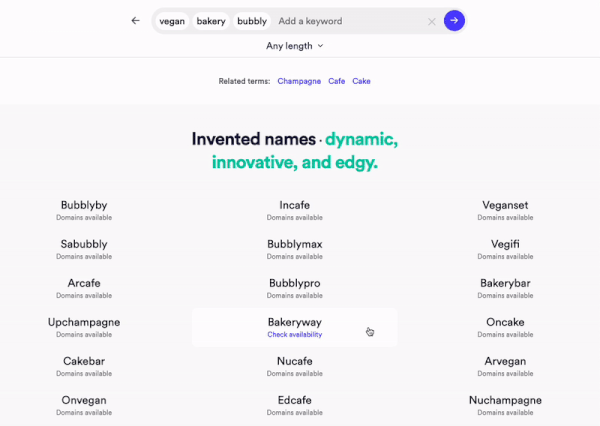
Once you’ve decided on a business name, revisit your brand’s vision, mission, and values – does your name reflect any or all three? If so, you’re one step closer to creating a strong brand.
5. Come up with a slogan/tagline
When creating your slogan, keep your company’s mission and purpose in mind. You’ll want to sum up your business purpose in a single sentence that you use in your marketing and social assets. Your slogan should be short and catchy to make a strong impression and remain memorable!
To get started you can take several approaches:
- Make your claim — Example: Carlsberg – “Probably the Best Beer in the World”
- Use a metaphor — Example: Skittles – “Taste the Rainbow”
- Tell ‘em what to do — Example: Apple – “Think Different.”
- Leverage labels — Example: Cards Against Humanity – “A party game for horrible people.”
- Get poetic — Example: Folgers Coffee – “The best part of wakin’ up is Folgers in your cup.”
- Compliment your customers: Example: L’Oreal – “Because you’re worth it”
- Be descriptive: Example: M&M’s – “Melts in your mouth, not in your hands.”
- Play on emotions: Example: Mastercard – “There are some things money can’t buy. For everything else, there’s Mastercard.”
TIP: Your slogan should be a direct reflection of your brand voice. If your brand were a person, what would it sound like? Is it going to be empowering? Fun? Silly?
A 2023 study found that slogans that are more likable are less memorable, whereas slogans that are less likable are more memorable.
How to build your brand’s visual identity
Now that you have the foundation of your brand strategy, it’s time for the fun part — coming up with your visual identity! This consists of:

Let’s break down what each elementt is and how you can create your own.
1. A logo

A logo is the face of your brand — it’s the tip of the brand identity iceberg! Consider your audience and what would resonate with them, while effectively communicating who you are and what you do as a business.
When designing your logo, it should be timeless and scalable so you’ll have a lasting design that can easily be used in a variety of mediums.
Whether you’re a designer or not, it helps to keep the following five tips in mind when it comes to logo design:
- Keep it simple
- Make it memorable
- Test for versatility
- Ask, “is it appropriate?”
- Create for the long-term
Ask yourself if your logo captures the essence of your brand. If so, you can move on to the next step.
Create your logo now!
2. A color palette

Your logo will already have the foundation of your color palette.
Think of the impact color can have on your brand. The famous Tiffany Blue is associated with feelings of surprise, joy, and awe. Tiffany’s has done a solid job of incorporating its brand color; people can’t help but recognize the brand before even seeing the logo.
When deciding which colors will convey the feeling you want to communicate, brush up on some basic colors and emotions. Your brand color palette can have 3 to 8 colors:
- 1 main color
- 2 primary colors
- 3-5 complementary and accent colors
Be wise in choosing color combinations that differentiate you from competitors to avoid confusing consumers.
Experiment with different tints and shades, and don’t be shy to explore colors not commonly used within your industry! The more you stand out from competitors, the better.
3. Typography

The magical loops and swirls of the iconic Disney logo custom typeface simply wouldn’t make sense if used anywhere other than for Disney’s marketing material. Spotting their typeface anywhere will automatically trigger the thought of the happiest place on earth.
Your logo font choice sends a message of who and what your brand is. Choose one to two fonts to use for headings and body text and stick to them across channels (it could be the font pair used in your logo or complementary typefaces). You can also choose one main font and use different cuts and weights.
Read more about font trends and how to choose the right one.
4. Shapes and imagery

Shapes and imagery play a fundamental role in visual communication. Consider how you want your audience to feel when they come across your brand. For example, using rounded shapes communicates feelings of unity and comfort, while hard-edged shapes are better suited for displaying stability and reliability.
Deepen your audience’s attachment to your brand by strategically choosing shapes and imagery. Choose impactful visuals that will resonate with your target audience.
Tip: When choosing imagery, think about your brand voice: is your voice loud and bold? Modern and edgy? Your images should reflect that to ensure a cohesive visual communication strategy.
5. Brand guidelines
An important part of your brand identity is guidelines on how to use your logo and brand image assets. This keeps things consistent and helps build trust with customers.
Brand guidelines often include:
- Logo elements – the elements that make up your logo (wordmark, icon, and slogan)
- Color variations – the primary version of your logo, along with black and white variations
- Clear space — also known as padding, safety space, and exclusion zone, ensures maximum visibility and impact
- Unacceptable uses – examples of what not to do with the logo design to prevent it from being altered.
Include your mission statement, visual rules for images and icons, brand voice strategy, specifications for packaging, and email marketing in your guidelines.
To maintain brand association in the minds of consumers, use your brand assets consistently across all marketing touchpoints. Brand guidelines are useful when:
- Designing brand assets
- Working with a graphic designer
- Working with a print shop
- Bringing on a new employee
Below is an example of brand guidelines, generated through AI with Looka’s brand kit!
Where to incorporate your brand identity
Part of establishing a consistent brand is staying true to it to instill trust in your customers while providing direction to your team (even if that team is just you).
Here’s how you can start integrating your brand into your business:
Website

Your website is the digital face of your business. Make sure it’s consistent so people trust it enough to buy from you!
- Use your brand colors as your header, highlight color, and footer.
- Use your brand fonts as the main fonts on your website
- Make sure your brand voice is consistent throughout your messaging
- Include your brand images and patterns throughout
- Prioritize fast loading speeds with clean and simple layouts
Not sure what kind of website you need? Check out our blog on types of websites with layout inspiration!
Product packaging
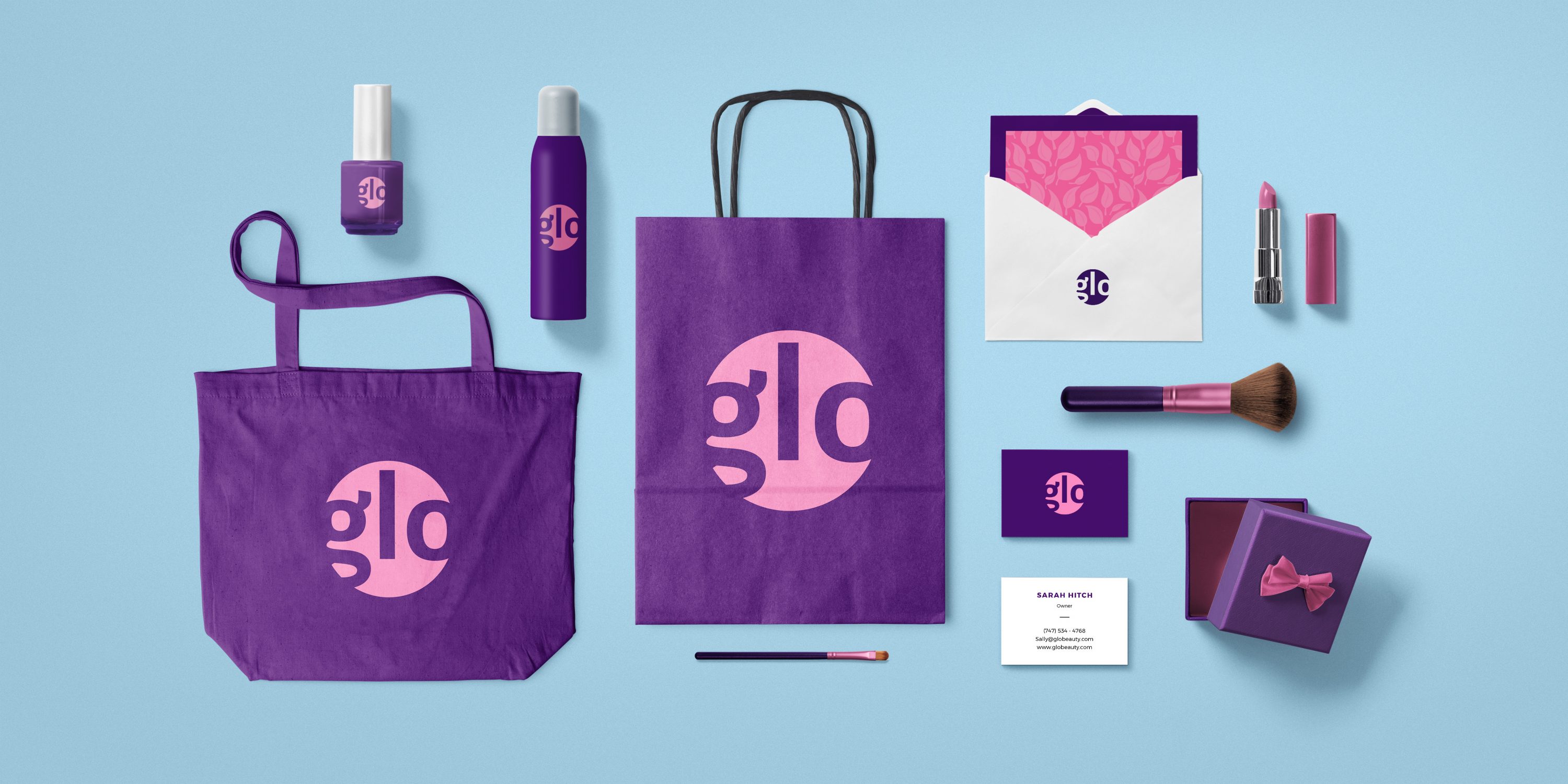
If you sell physical products, having a sublime unboxing experience is critical to getting social media mentions, user-generated content, and making a good impression.
Include your brand imagery, patterns, and logo on the package. Include a branded thank you note to top it off!
Business cards

Business cards are a serendipitous way to get the word about your business around. Make sure they’re branded with your logo, fonts, and brand colors, along with your information.
Email signature
Adding your logo and brand fonts to your email signature adds trust and professionalism that can garner more replies and collaborations from others. A simple branded email signature can help you can gain more authenticity!
Social media channels
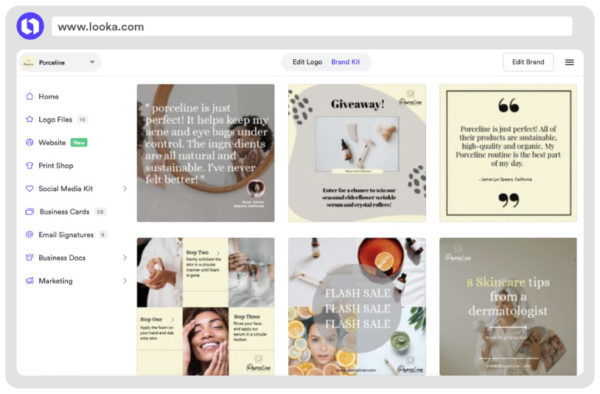
No one will follow or reply to an account that looks amateur or fake. Add your logo as your social media icon, and make your social media handle easily recognizable.
Use your brand colors and fonts to make your feed effortlessly on brand. Life is easier when you’ve ironed out your brand guidelines!
Apparel and stationery
For localized or online businesses, spread the word by getting branded swag to give out to customers and friends. Add your logo to everyday items like linen totes, t-shirts, or notebooks. If people use them, it becomes free brand marketing for you!
A brand identity takes time
The branding process should never be rushed. It’s important to clearly define your brand strategy early on, so you can build on it as you grow your business.
If you’re starting out by yourself, make sure to spend a bit of time thinking about the brand you want to build. On this exciting journey, remember to:
- Understand why branding is important
- Create a concrete strategy that defines your target audience
- Establish your brand’s identity and use it consistently across channels
Once you come up with your strategy and design your logo, you’ll already have taken a big step in building your brand. Your brand identity will come together to support your business and build trust and recognition among customers.
Show the world what you’ve got!
Brand Identity FAQs
What is a brand identity, with examples?
A brand identity is the physical and digital result of branding. It is the collection of digital and tangible brand elements that a company creates to portray the right image of itself to its target audience.
Here are some brand identity examples to check out:
- Starbucks
- Mailchimp
- Gucci
We’ve outlined their brand identities above!
What are the 4 elements of brand identity?
The four elements of a brand identity are:
- A logo
- A color palette
- Shapes and imagery
- Brand guidelines
What are the 5 steps to brand identity?
Here are 5 steps to creating a brand identity:
- Find your niche and study your competition
- Define your target audience
- Find your brand purpose is and why
- Choose a business name
- Create a slogan/tagline
What is the key to brand identity?
The key to brand identity is consistency. Consistency ensures that all brand elements, such as logos, colors, fonts, and messaging, work together cohesively across all platforms and interactions. This unified approach helps to build a strong, recognizable brand that resonates with the audience and creates a lasting impression.
Why is brand identity important?
Brand identity is important because it:
- Differentiates Your Brand: A strong brand identity helps distinguish your brand from competitors, making it easier for customers to recognize and remember you.
- Builds Trust and Loyalty: Consistent and clear brand identity fosters trust and loyalty among customers, as they know what to expect from your brand.
- Creates Emotional Connections: Effective brand identity can evoke emotions and connections, making your brand more relatable and appealing to your target audience.
- Supports Marketing Efforts: A well-defined brand identity provides a foundation for all marketing materials and campaigns, ensuring they are aligned and effective.
- Enhances Business Value: A strong brand identity can increase your business’s perceived value, attract high-quality talent, and create a competitive edge in the market.
These aspects underscore the critical role of brand identity in establishing a successful and sustainable brand presence.





